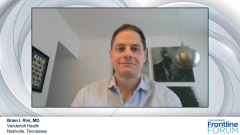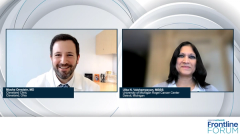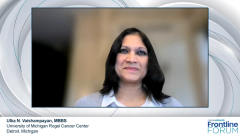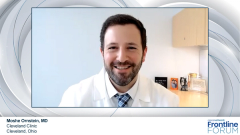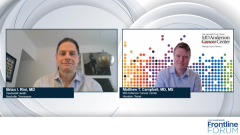
Frontline Clinical Trial Data in Advanced Renal Cell Carcinoma
Expert hematologist-oncologists share comprehensive perspective on an array of first-line clinical trials in the setting of advanced renal cell carcinoma.
Episodes in this series

Transcript:
Moshe Ornstein, MD: I thought something was interesting at the recent conference we were at, [the 2022] IKCS [International Kidney Cancer Symposium]. There were some updates to some of the large clinical trials that shaped how we treat patients today in the frontline setting. I’ll start by asking you about the update on subsequent therapy [in] CheckMate 214 [NCT02231749] and what you thought about those data.
Ulka N. Vaishampayan, MBBS: The 1 big reservation many providers seem to have for using steroids when giving immune therapy—that has been proven to not be a concern for immune checkpoint therapy. It should be indicated to start steroids sooner rather than later, especially if you suspect an immune-related adverse event. In CheckMate 214, 60% of the patients received steroids, and there [were] still good long-term outcomes. The long-term outcomes that were reported [with this therapy] and brought up this year at different meetings [were] 5- and 6-year follow-ups. So, 2- and 3-year follow-ups [are] showing us that the combination of ipilimumab and nivolumab has a better chance of producing long-term remissions. For the patients who are in remission at 2 years, for instance, they have [approximately] a 90% chance of remaining in remission longer term with longer follow-up. The median survival in this patient population with [ipilimumab and nivolumab] has been [approximately] 55.7 months with all-comers. Specifically in the intermediate and poor risk group, it’s [approximately] 48 months. To get a 4-year median survival is pretty remarkable with immune checkpoint therapy in advanced kidney cancer. So far, the results of long-term follow-up from the immune checkpoint combination are looking very promising. What do you think about the VEGF [vascular endothelial growth factor] TKI [tyrosine kinase inhibitor] and IO [immuno-oncology] combination? Some of those have reported long-term follow-up, more follow-up, or more mature follow-up, [such as] the CLEAR trial [NCT02811861]. Can you comment on that?
Moshe Ornstein, MD: There’s a couple things to remember. The IO/TKIs are always going to have some degree of a disadvantage to [ipilimumab and nivolumab], [because that combination] has the longest follow-up. We don’t know, in terms of the long-term follow-up, [whether] it’s going to have the highest tail of the curve of patients alive or alive off therapy 5, 6, [or] 7 years down the road. It’s been really encouraging to see that. Everything with the IO/TKIs is lagging 18 [or more] months behind it. It is encouraging to see updated data presented both at IKCS and at [the European Society for Medical Oncology Congress 2022] that [show] many of those responses are still seen. It’s not that because they didn’t get ipilimumab, they don’t have any tail of the curve. We don’t know what that’s going to be like.
One of the questions that came up with the IO/TKIs is the question of subsequent therapy and [whether] subsequent therapy impacted the results we saw in terms of PFS [progression-free survival] and OS [overall survival]. It’s been encouraging to see the updates from the CLEAR study and from other trials that demonstrate that, regardless of subsequent therapy or [OS], those results are still holding up. The other thing we’re seeing is that not only is a response important, but it [also] appears that depth of response—that the degree to which the tumor burden shrinks—holds some prognostic value in terms of the outcome for patients. We look at this mark of 30% tumor burden reduction for a response, but with emerging data, such as what was presented with CheckMate 9ER [NCT03141177] with [cabozantinib and nivolumab], the depth of response is important, especially as we think about survival. It’s great to see the long-term data panning out for the IOs and the IO/TKIs, and it’s great to see subsequent therapies not being the difference between them.
Ulka N. Vaishampayan, MBBS: I agree. I think we’ll hear more of the story as we get more mature follow-up. But so far, for the VEGF TKI and IO combinations, everything seems to stay consistent with their initial results, which is reassuring. Similarly for KEYNOTE-426 [NCT02853331], the 30-month and 42-month data [were] reported with longer follow-up, and the results seem to be fairly consistent. There is a newer end point evolving, called PFS-2. Looking at the, as you said, second-line therapy that was used, and [whether] the patients responded or continued to have a shot at responding and getting benefit from the second-line therapy if they progressed on the frontline. It seemed like even there, the combination of axitinib and pembrolizumab continued to show better responses and PFS as compared [with] the patients on sunitinib, who had switched over to a different regimen, [which was] usually an immune checkpoint inhibitor.
Moshe Ornstein, MD: In many ways, what this has told us is at the end of the day, in the frontline setting, you must use what you think is best. You’ll figure out the refractory setting later, but the key is whatever regimen you’re most comfortable with, and that—based on the data—is best for the patient in front of you. That’s the one to give.
Ulka N. Vaishampayan, MBBS: I would also comment that the depth of response, as you said, is a critical piece, but 80% shrinkage was similar to CR [complete response], as was found in the CheckMate 9ER subgroup analysis, where they were similar in terms of predicting [OS]. So, some of it is that our response measuring is somewhat flawed, especially in the setting of immune checkpoint therapy, and that there isn’t a big difference. Eighty percent is similar to CR.
Moshe Ornstein, MD: I think that’s important. It tells us [that] the depth of response is important and to not go too crazy about the CRs. If a patient has a nice, solid response, that’s a good thing, even if its’s only 85% and not considered a CR by our clinical trial measures.
Ulka N. Vaishampayan, MBBS: Maintaining the response is probably a bigger critical piece. What about quality of life? Do you typically factor in that information when you’re making a decision?
Moshe Ornstein, MD: To be honest, I have trouble understanding all the quality-of-life data. For me, the most reassuring thing is that none of these studies showed quality of life that was worse than the historical standard. Although that might not be saying much because it was sunitinib. Still, it’s not that we’re harming patients by giving them IO-based combinations. Certainly, there’s very encouraging data with cabozantinib [plus] nivolumab and ipilimumab [plus] nivolumab in terms of the quality-of-life improvements. I think [what is] more important than the quality of life, per se, is the ability to and the understanding of how to manage toxicities. In general, patients feel better when their tumors are going away and managing their toxicities. Understanding when to start steroids or when to give a patient a break or a dose reduction of their TKI—that plays as much a role in quality of life as the surveys we’re giving out as part of these clinical trials.
Ulka N. Vaishampayan, MBBS: I absolutely agree. It is important to incorporate patient perception—and we do anyway when we see the patient—but that happy balance of toxicities and efficacy is critical to maintain in management of kidney cancer.
Transcript edited for clarity.
Newsletter
Stay up to date on recent advances in the multidisciplinary approach to cancer.


